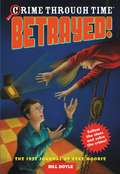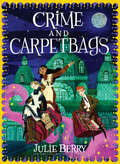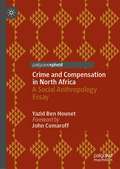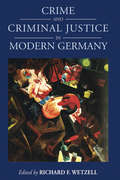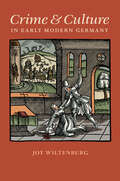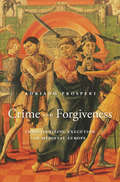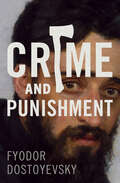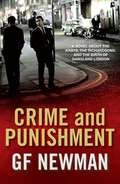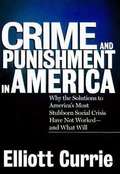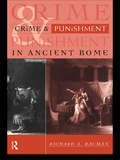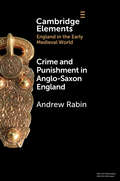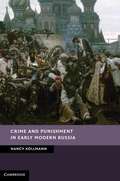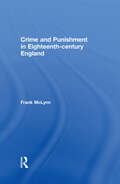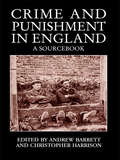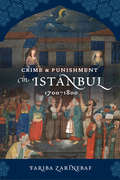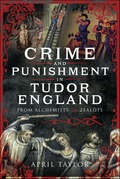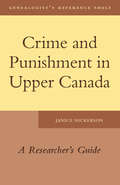- Table View
- List View
Crime Through Time #3: The 1969 Journal of Malcom Moorie (Crime Through Time #3)
by Bill DoyleMal Moorie enters a rural boarding school and gets involved in a plot involving endangered animals and a new pesticide.
Crime Through Time #4: The 1977 Journal of Zeke Moorie (Crime Through Time #4)
by Bill DoyleZeke Moorie joins a tour to fundraise and attract youth to a traveling King Tut exhibition. He discovers a plot involving an ankh necklace that may have belonged to the Pharaoh, and a box that's been locked for thousands of years.
Crime Through Time #5: The 2007 Journal of Nick Fitzmorgan (Crime Through Time #5)
by Bill DoyleNick Fitzmorgan unexpectedly returns home early from camp to find his father missing and the house in disarray. The house isn't a mess - it's set up with clues that will lead Nick all the way to his father's rescue.
Crime Through Time #6: Trapped! (Crime Through Time #6)
by Bill DoyleA combination sci-fi and mystery novel involving art fraud aboard the Space Elevator.
Crime and Carpetbags (Wishes and Wellingtons #2)
by Julie BerryFrom award-winning author Julie Berry comes the second installment in the fantastically adventurous Wishes and Wellingtons series, in which our heroine, Maeve Merritt, embarks on a magic-powered and most dangerous quest to help her friends.Now that Maeve Merritt has surrendered Mermeros, the djinni she found in a sardine can, she expects her life in London will be dull as dirt. But villains from Maeve's previous escapades are still searching for the djinni, now in the hands of Mr. Poindexter, the adoptive father of Maeve's friend Tommy. When Mr. Poindexter tries to use one of his wishes, he and Mermeros go missing—and without a guardian, Tom will be forced back to the orphanage.With the help of magical flying carpetbags, Maeve, Tom, and their friend Alice soar off to find Mr. Poindexter and that rascal, Mermeros, before the djinni's fabled wishes fall into the wrong hands.The perfect book for:Anyone looking for middle grade booksParents, teachers, or librarians looking for kids books ages 8 to 10Young fantasy readers Ages 8-11Empowering young girls
Crime and Community in Reformation Scotland: Negotiating Power in a Burgh Society (Perspectives in Economic and Social History #23)
by J R FalconerBased on church and state records from the burgh of Aberdeen, this study explores the deeper social meaning behind petty crime during the Reformation. Falconer argues that an analysis of both criminal behaviour and law enforcement provides a unique view into the workings of an early modern urban Scottish community.
Crime and Compensation in North Africa: A Social Anthropology Essay
by Yazid Ben HounetAs the 21st century began, Algeria, Morocco, and North Sudan launched some much-publicised “reconciliation” policies, or, in the case of North Sudan, “pacification” policies. Algeria, following its Clemency policy (1995) and Civil Concord Law (1999), held a referendum in 2005 and subsequently implemented the measures of its Charter for Peace and National Reconciliation. This charter is Algeria’s latest policy aimed at settling the accounts of a murderous decade (1990s) between the state and armed Islamic groups. In Morocco, an arbitration committee was set up in 1999, followed by the Equity and Reconciliation Commission in 2004, to turn the page on the “Years of Lead”—a period during the rule of King Hassan II during which state crimes such as torture, imprisonment, and murder were committed. Finally, in Sudan (North Sudan since 2011), peace negotiations were held in 1989 and a peace process has been ongoing since 2005, with an aim to resolve violent conflicts and war crimes that are shaking Darfur and North Kordofan. At the centre of all these reconciliation and pacification mechanisms lies a practice that has been scarcely studied: (monetary) compensation for the crimes committed.Shedding light on this under-studied topic from the North African field, this volume investigates: What meanings can compensation have when it is aimed at repairing crimes? Is it necessary, sufficient, or admissible? How can it be implemented and accepted by the victims themselves and by society? These questions about compensation lead the reader through discussions on the nature of crime, punishment, reparation, reconciliation, and the way these concepts were and are now understood in these three North African countries.
Crime and Corruption at the Yard: Downfall of Scotland Yard
by David I. WoodlandA Scotland Yard insider blows the whistle on police corruption in &“a book . . . that everyone concerned with law and order should read&” (Crime Review). During David Woodland&’s nineteen years of service with the United Kingdom&’s Metropolitan Police, the &‘thin blue line&’ came under intense pressure. In addition to the routine caseload of gang crime, murder, and armed robbery, Irish terrorist groups launched a vicious and prolonged campaign of violence. Also, then-Police Commissioner Sir Robert Marks described the Criminal Intelligence Department as &‘the most routinely corrupt organization in London&’, it may have been an exaggeration made out of anger—but it devastated the public&’s faith in the CID. New Scotland Yard Det. Inspector David Woodland was witness to a series of major scandals and now reveals why many otherwise honest detectives strove to bend the law to their own devices. Using his own cases and experience, he demonstrates the difficulties working in a depleted, demoralized police force—not to mention fighting to overcome &‘the enemy within&’. Crime and Corruption at The Yard is a gripping, shocking, and instructive insider&’s account of the darker side of police work.
Crime and Criminal Justice in Modern Germany (Studies in German History #16)
by Richard F. WetzellThe history of criminal justice in modern Germany has become a vibrant field of research, as demonstrated in this volume. Following an introductory survey, the twelve chapters examine major topics in the history of crime and criminal justice from Imperial Germany, through the Weimar and Nazi eras, to the early postwar years. These topics include case studies of criminal trials, the development of juvenile justice, and the efforts to reform the penal code, criminal procedure, and the prison system. The collection also reveals that the history of criminal justice has much to contribute to other areas of historical inquiry: it explores the changing relationship of criminal justice to psychiatry and social welfare, analyzes representations of crime and criminal justice in the media and literature, and uses the lens of criminal justice to illuminate German social history, gender history, and the history of sexuality.
Crime and Culture in Early Modern Germany (Studies in Early Modern German History)
by Joy WiltenburgWith the growth of printing in early modern Germany, crime quickly became a subject of wide public discourse. Sensational crime reports, often featuring multiple murders within families, proliferated as authors probed horrific events for religious meaning. Coinciding with heightened witch panics and economic crisis, the spike in crime fears revealed a continuum between fears of the occult and more mundane dangers.In Crime and Culture in Early Modern Germany, Joy Wiltenburg explores the beginnings of crime sensationalism from the early sixteenth century into the seventeenth century and beyond. Comparing the depictions of crime in popular publications with those in archival records, legal discourse, and imaginative literature, Wiltenburg highlights key social anxieties and analyzes how crime texts worked to shape public perceptions and mentalities. Reports regularly featured familial destruction, flawed economic relations, and the apocalyptic thinking of Protestant clergy. Wiltenburg examines how such literature expressed and shaped cultural attitudes while at the same time reinforcing governmental authority. She also shows how the emotional inflections of crime stories influenced the growth of early modern public discourse, so often conceived in terms of rational exchange of ideas.
Crime and Deviance in Cyberspace (International Library Of Criminology, Criminal Justice And Penology - Second Ser. #Vol. 2)
by David S. WallThis volume presents the reader with an interesting and, at times, provocative selection of contemporary thinking about cybercrimes and their regulation. The contributions cover the years 2002-2007, during which period internet service delivery speeds increased a thousand-fold from 56kb to 56mb per second. When combined with advances in networked technology, these faster internet speeds not only made new digital environments more easily accessible, but they also helped give birth to a completely new generation of purely internet-related cybercrimes ranging from spamming, phishing and other automated frauds to automated crimes against the integrity of the systems and their content. In order to understand these developments, the volume introduces new cybercrime viewpoints and issues, but also a critical edge supported by some of the new research that is beginning to challenge and surpass the hitherto journalistically-driven news stories that were once the sole source of information about cybercrimes.
Crime and Forgiveness: Christianizing Execution in Medieval Europe
by Adriano ProsperiA provocative analysis of how Christianity helped legitimize the death penalty in early modern Europe, then throughout the Christian world, by turning execution into a great cathartic public ritual and the condemned into a Christ-like figure who accepts death to save humanity. The public execution of criminals has been a common practice ever since ancient times. In this wide-ranging investigation of the death penalty in Europe from the fourteenth to the eighteenth century, noted Italian historian Adriano Prosperi identifies a crucial period when legal concepts of vengeance and justice merged with Christian beliefs in repentance and forgiveness. Crime and Forgiveness begins with late antiquity but comes into sharp focus in fourteenth-century Italy, with the work of the Confraternities of Mercy, which offered Christian comfort to the condemned and were for centuries responsible for burying the dead. Under the brotherhoods’ influence, the ritual of public execution became Christianized, and the doomed person became a symbol of the fallen human condition. Because the time of death was known, this “ideal” sinner could be comforted and prepared for the next life through confession and repentance. In return, the community bearing witness to the execution offered forgiveness and a Christian burial. No longer facing eternal condemnation, the criminal in turn publicly forgave the executioner, and the death provided a moral lesson to the community. Over time, as the practice of Christian comfort spread across Europe, it offered political authorities an opportunity to legitimize the death penalty and encode into law the right to kill and exact vengeance. But the contradictions created by Christianity’s central role in executions did not dissipate, and squaring the emotions and values surrounding state-sanctioned executions was not simple, then or now.
Crime and Justice since 1750
by Paul Lawrence Barry GodfreyThis book provides a comprehensive, introductory text for students taking courses in crime and criminal justice history. It covers all of the key historical topics central to an understanding of the current criminal justice system, including the development of the police, the courts and the mechanisms of punishment (from the gallows to the prison). The role of the victim in the criminal justice system, changing perceptions of criminals, long-term trends in violent crime, and the rise of surveillance society also receive detailed analysis. In addressing each of these issues and developments, the authors draw on the latest research in this rapidly expanding field to explore a range of historiographical and criminological debates. This new edition continues its exploration of criminal justice history right through to the present day and discusses recent events in the criminal justice world. Each chapter now ends with a ‘Modern parallels’ section - a detailed case study providing historical analysis pertinent to a specific contemporary issue in the field of criminal justice and drawing parallels between historical context and modern phenomenon. Each chapter also includes a ‘Key questions’ section, which guides the reader towards appropriate sources for further study. The authors draw on their in-depth knowledge and provide an accessible and lively guide for those approaching the subject for the first time, or those wishing to deepen their knowledge. This makes the book essential reading for those teaching or studying modules on criminal justice, policing and youth justice.
Crime and Punishment
by Fyodor DostoyevskyThe acclaimed Russian novelist’s epic morality tale of a young man’s horrifying crime and his struggle for redemption. Rodion Raskolnikov, a young man living in St. Petersburg, devises a gruesome experiment in morality. Theorizing that men of exceptional intelligence have license to kill others, he decides to test his theory with the murder of an elderly pawnbroker. Though no evidence can link him to his crime, it leaves him so deeply disturbed that he fights a constant urge to confess. Despite this, Raskolnikov goes on with his life, contending with his younger sister’s plan to marry a man of dubious character and the fate of an impoverished family for whom he feels responsible. In Fyodor Dostoyevsky’s acutely observed psychological drama, readers meet an array of brilliantly realized characters. There is Arkady Svidrigailov, the wealthy, married man infatuated with Raskolnikov’s sister; Sonya Marmeladov, the innocent young woman forced by poverty into a life of prostitution; Detective Porfiry Petrovitch, who suspects Raskolnikov but cannot prove his guilt; and Raskolnikov himself, whose horrifying offense leaves him in a long and agonizing struggle toward redemption. First published in 1866 in the Russian Messenger literary journal, Crime and Punishment met with sensational acclaim and catapulted Dostoyevsky to the pinnacle of literary fame. This ebook has been professionally proofread to ensure accuracy and readability on all devices.
Crime and Punishment
by G. F. NewmanIn 1951 the Festival of Britain marks a new golden age of hope and prosperity for the country. Things are certainly looking up for the criminal elite who run the East End. For Jack, a draft-dodger with aspirations to be a champion boxer, there's easy money to be made for providing a bit of muscle. Meanwhile his sister Kath must keep secret the fact that she killed their father to protect her son, Brian, from the abuse she experienced as a child. Brian is so traumatized by witnessing this event that the complex union of violence and sexuality will shape his character for life.As the years go by and disillusion sets in, successive Labour and Tory governments aren't able to stop the rot. Younger, nastier criminals like the Kray twins and the Richardson brothers begin to carve out their own criminal empires and crush all resistance. Brutalised and embittered by years of failure and imprisonment, Jack decides to make a stand. The stage is set for one big war.Crime and Punishment is the first volume in a two-part epic, and follows the characters' lives up until the accession of Thatcher. The second volume will trace the dramatic changes in criminal society that reflected the wider social upheaval of the times, right up until the present day.
Crime and Punishment in America
by Elliott CurrieThere are five times as many Americans behind bars today as in 1970. The national incarceration rate in 1997 was twice that in 1985. California's prison system has become the third largest in the world.
Crime and Punishment in Ancient Rome
by Richard A. BaumanFirst Published in 2004. Routledge is an imprint of Taylor & Francis, an informa company.
Crime and Punishment in Anglo-Saxon England (Elements in England in the Early Medieval World)
by Andrew RabinArguably, more legal texts survive from pre-Conquest England than from any other early medieval European community. The corpus includes roughly seventy royal law-codes, to which can be added well over a thousand charters, writs, and wills, as well as numerous political tracts, formularies, rituals, and homilies derived from legal sources. These texts offer valuable insight into early English concepts of royal authority and political identity. They reveal both the capacities and limits of the king's regulatory power, and in so doing, provide crucial evidence for the process by which disparate kingdoms gradually merged to become a unified English state. More broadly, pre-Norman legal texts shed light on the various ways in which cultural norms were established, enforced, and, in many cases, challenged. And perhaps most importantly, they provide unparalleled insight into the experiences of Anglo-Saxon England's diverse inhabitants, both those who enforced the law and those subject to it.
Crime and Punishment in Early Modern Germany: Courts and Adjudicatory Practices in Frankfurt am Main, 1562–1696
by Maria R. BoesFrankfurt am Main, in common with other imperial German cities, enjoyed a large degree of legal autonomy during the early modern period, and produced a unique and rich body of criminal archives. In particular, Frankfurt’s Strafenbuch, which records all criminal sentences between 1562 and 1696, provides a fascinating insight into contemporary penal trends. Drawing on this and other rich resources, Dr. Boes reveals shifting and fluid attitudes towards crime and punishment and how these were conditioned by issues of gender, class, and social standing within the city’s establishment. She attributes a significant role in this process to the steady proliferation of municipal advocates, jurists trained in Roman Law, who wielded growing legal and penal prerogatives. Over the course of the book, it is demonstrated how the courts took an increasingly hard line with select groups of people accused of criminal behavior, and the open manner with which advocates exercised cultural, religious, racial, gender, and sexual-orientation repressions. Parallel with this, however, is identified a trend of marked leniency towards soldiers who enjoyed an increasingly privileged place within the judicial system. In light of this discrepancy between the treatment of civilians and soldiers, the advocates’ actions highlight the emergence and spread of a distinct military judicial culture and Frankfurt’s city council’s contribution to the quasi-militarization of a civilian court. By highlighting the polarized and changing ways the courts dealt with civilian and military criminals, a fuller picture is presented not just of Frankfurt’s sentencing and penal practices, but of broader attitudes within early modern Germany to issues of social position and cultural identity.
Crime and Punishment in Early Modern Russia
by Nancy KollmannThis is a magisterial new account of the day-to-day practice of Russian criminal justice in the seventeenth and early eighteenth centuries. Nancy Kollmann contrasts Russian written law with its pragmatic application by local judges, arguing that this combination of formal law and legal institutions with informal, flexible practice contributed to the country's social and political stability. She also places Russian developments in the broader context of early modern European state-building strategies of governance and legal practice. She compares Russia's rituals of execution to the 'spectacles of suffering' of contemporary European capital punishment and uncovers the dramatic ways in which even the tsar himself, complying with Moscow's ideologies of legitimacy, bent to the moral economy of the crowd in moments of uprising. Throughout, the book assesses how criminal legal practice used violence strategically, administering horrific punishments in some cases and in others accommodating with local communities and popular concepts of justice.
Crime and Punishment in Eighteenth Century England
by Frank McLynnMcLynn provides the first comprehensive view of crime and its consequences in the eighteenth century: why was England notorious for violence? Why did the death penalty prove no deterrent? Was it a crude means of redistributing wealth?
Crime and Punishment in England: A Sourcebook
by Andrew Barrett Christopher HarrisonDesigned to complement "Crime and Punishment: An Introductory History" UCL Press, 1996, this sourcebook contains documents specifically selected to illuminate major issues raised in the textbook. In the first part of the book, extracts of laws and royal, local and church records from Anglo- Saxon England to the 18th century reveal changing patterns of crime and punishment. The first sociology of English crime Harman's Caveat, 1566 as well as Henry Fielding's reform proposals of the mid-eighteenth century are included and the growing use of imprisonment is reflected in the later sections.; The second part covers the 19th century. Documents range from commentaries on the day-to-day crimes of theft, drunkenness And Assault To The Sensationalism Of Garroting And Murder. Documents charting the impressive growth of the police force are included. Criminal justice is approached through the minutiae of police charge books and newspaper column's, the personal reminiscences of magistrates, the sweeping arguments of law reformers and the pleading voices of Petitioners For Mercy. In A Chapter On Punishment, The Emotions Unleashed by public hanging and transportation can be compared with the relentless monotony of prison life.
Crime and Punishment in Istanbul
by Fariba ZarinebafThis vividly detailed revisionist history exposes the underworld of the largest metropolis of the early modern Mediterranean and through it the entire fabric of a complex, multicultural society. Fariba Zarinebaf maps the history of crime and punishment in Istanbul over more than one hundred years, considering transgressions such as riots, prostitution, theft, and murder and at the same time tracing how the state controlled and punished its unruly population. Taking us through the city's streets, workshops, and houses, she gives voice to ordinary people--the man accused of stealing, the woman accused of prostitution, and the vagabond expelled from the city. She finds that Istanbul in this period remains mischaracterized--in part by the sensational and exotic accounts of European travelers who portrayed it as the embodiment of Ottoman decline, rife with decadence, sin, and disease. Linking the history of crime and punishment to the dramatic political, economic, and social transformations that occurred in the eighteenth century, Zarinebaf finds in fact that Istanbul had much more in common with other emerging modern cities in Europe, and even in America.
Crime and Punishment in Tudor England: From Alchemists to Zealots
by April TaylorDon't miss out on this riveting read that will transport you back in time and leave you with a deeper understanding of law enforcement in medieval England! Crime and Punishment in Tudor England tells the story of the enactment of law and its penalties from Henry VII to Elizabeth I. The sixteenth century was remarkable in many ways. In England, it was the century of the Tudor Dynasty. It heralded the Reformation, William Shakespeare, the first appearance of bottled beer in London pubs, Sir Francis Drake, and the Renaissance. Oh, and the Spanish Armadas—all five of them! Yes, five armadas and all failures. It was a watershed century for crime and punishment. Henry VII’s paranoia about the loyalty of the nobility led to military-trained vagrants causing mayhem and murder. Henry VIII’s Reformation meant executions of those refusing to take the Oath of Supremacy. State-controlled religion—summed up through the five reigns as Roman Catholic; Anglo-Catholic; Protestant; Roman Catholic, and Sort of Protestant but I don’t mind so long as you swear the Oath of Supremacy—became an increasingly complex, not to say confusing, issue for ordinary people. Although primary sources are rare and sometimes incomplete, the life of criminals and the punishments meted out to them still fascinates. Read about John Daniell and how he tried to blackmail the Earl of Essex; the Stafford insurrection of 1486, the first serious opposition to the new king; the activities of con-man extraordinaire, Gregory Wisdom, and many more. Crime and punishment didn’t start with the Tudors and this book summarizes judicial practices built on tradition from the Roman occupation. It covers often gory details—what happens to the body when it is beheaded, burned, boiled, or hanged? Arranged in alphabetical order of crimes, it recounts tales of blackmail, infanticide, kidnapping, heresy, and sumptuary laws. Told with occasional low-key humor, the book also includes Tavern Talk, snippets of quirky information. Dip into it at your pleasure.
Crime and Punishment in Upper Canada: A Researcher's Guide
by Janice NickersonCrime and Punishment in Upper Canada provides genealogists and social historians with context and tools to understand the criminal justice system and locate sources on criminal activity and its consequences for the Upper Canada period (17911841) of Ontarios history. Illustrative examples further aid researchers in this era of the provinces past, which is notoriously difficult to investigate due to paucity of records and indexes. An entertaining, educational read, the book features chapters with detailed inventories of available records in federal, provincial, and local repositories; published transcripts and indexes; online transcripts and indices; and suggestions for additional reading. Also included are engravings (jails and courthouses, public hangings, judges), maps (showing the boundaries of districts), charts (for statistics such as frequencies of different kinds of offences), and document examples (court minutes, jail registers, newspaper reports, et cetera), while case studies demonstrate the use and relevance of various records.

